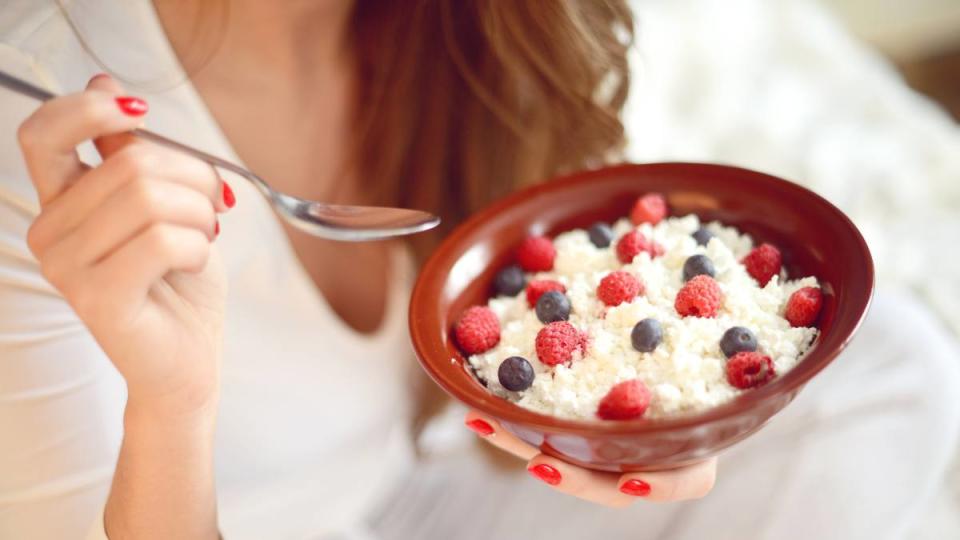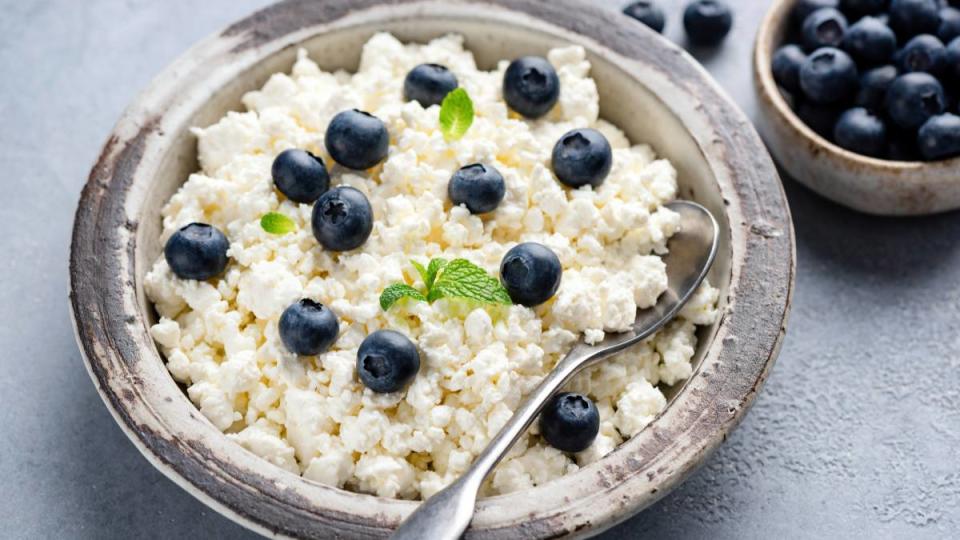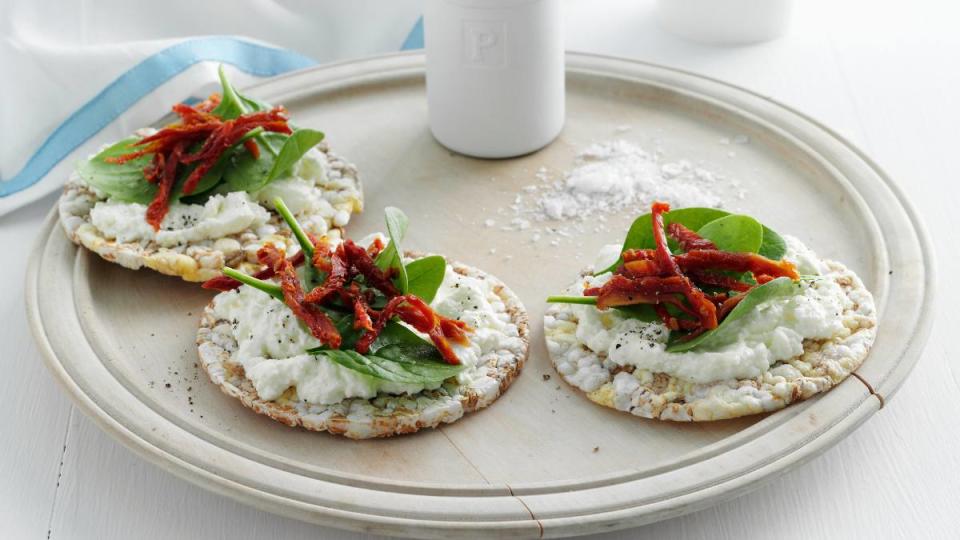What Nutrition Experts Say about the Cottage Cheese Trend
In my early memories, cottage cheese was a peculiar spread my mother would pair with cinnamon-flavored graham crackers for lunch. Many other women swore by it as a diet food. Fast forward to today, and cottage cheese is the hottest ingredient around: The protein-packed dairy product has transformed into a versatile ingredient: People on social media are using it to make bagels, pizza bowls, sweet (and savory) cottage cheese toast and more. Tiktokkers are even posting about cottage cheese shortages! No doubt about it, the cottage cheese trend is here to stay. But is cottage cheese the miracle ingredient it's made out to be? And for those who have yet to embrace it in their culinary adventures, where does one begin? Read on for all the answers.
What is cottage cheese?

Cottage cheese is a soft cheese that’s made by pouring an acidic ingredient, like vinegar or a bacteria culture, into milk. This causes the milk’s solids to separate from a liquid protein called whey. You can find cottage cheese in small or large curd varieties.
Why is cottage cheese so popular?
Beyond its creamy texture and versatile flavor profile, cottage cheese boasts impressive nutritional credentials — and millions of women are searching for delicious foods that will help them on their quest for healthy eating. Gal Shua-Haim, MS, RD, the registered dietitian and culinary expert behind the blog and Instagram platform, Something Nutritious, emphasizes its protein, calcium and B vitamin content, dubbing it a "miracle ingredient" for its nutritional value and adaptability in recipes.
Whether blended into pasta sauces, used as a dip for crackers and veggies or layered under avocado on toast, cottage cheese lends a creamy texture and protein-rich boost to dishes. With its ability to elevate dishes and cater to diverse culinary preferences, cottage cheese is now viewed as a refrigerator staple rather than a mere “diet food,” notes Adeena Sussman, New York Times best-selling author of Shabbat.
Related: Eating This Much Protein in the Morning Can Boost Weight Loss, According to Experts
With approximately 14 grams of protein per half-cup serving, cottage cheese provides a satiating and muscle-building source of this essential nutrient. Additionally, cottage cheese is a rich source of calcium, offering up to 10% of your daily calcium needs in a single serving. Its B vitamin content, including riboflavin, niacin, and B12, supports energy metabolism and nerve function, making cottage cheese a valuable addition to your diet.
How to work cottage cheese into your diet
The idea of incorporating cottage cheese into your cooking repertoire may seem daunting at first, acknowledges Sussman. However, she encourages aspiring chefs and home cooks to “experiment with brands and varieties to see what you like best.” Whether blended into batter for added protein or mixed with ricotta in lasagnas, SHua-Haim notes that cottage cheese adds a creamy texture and nutritional boost to various recipes. Its versatility extends to smoothies, cheesecakes and breakfast toast, offering a wholesome addition to everyday meals. Here's how to get started.
Choose your cottage cheese

From whipped to regular, small to large curd, the options are vast, each offering a unique texture and flavor profile. Whether you prefer the airy consistency of whipped cottage cheese or the richness of small curd, there is a type to suit every palate.
“Whipped or small-curd are my top choices,” says Shua-Haim, “especially if you’re not a fan of the texture of cottage cheese.” There are also creamier full-fat options versus a lighter lower-fat cottage cheese. “I personally prefer full-fat because it’s creamier and more satiating,” claims Shua-Haim.
Related: Whipped Cottage Cheese: An Ultra-Creamy + Delicious Protein Superfood — 3 Meal Ideas
Add flavor to cottage cheese

Today, brands offer a range of flavors and enhancements, allowing for endless culinary creativity. Whether you opt for a sweet pineapple-infused cottage cheese or a savory dill-flavored variation, the possibilities are endless. And even if you start with the plain stuff, Sussman recommends adding your own twist to cottage cheese by incorporating fresh fruit, nuts, maple syrup or nutritional yeast. These flavor enhancements pair perfectly with crackers, vegetables, or fruit salads, catering to both sweet and savory preferences. (Click through to learn more about the benefits of nutritional yeast.)
Related: Cottage Cheese Bread Has Just 2 Ingredients, Boasts 50% More Protein + It’s Easy To Make
Experiment with recipes

“Cottage cheese has a mild and creamy texture, making it easy to incorporate into so many dishes,” says Shua-Haim. Two delicious recipes: creamy pasta sauces and protein-packed pancakes — a favorite of Shua-haim's: “Blending it into pancake batter for an added boost of protein and fluffiness has been my go-to for a nourishing breakfast.” Its blank-canvas nature allows for endless flavor combinations, whether sweet or savory. Experiment with different varieties of cottage cheese to find the one that best suits your taste preferences and culinary creations. Mix and match with fruits, nuts, herbs, or spices to create unique and delicious dishes that cater to your personal preferences. "I love enjoying a savory cottage cheese bowl with crackers, veggies and a hard-boiled egg," says Shua-Haim. Check out this reel for her easy recipe:
More creative uses for cottage cheese

For those seeking innovative ways to use cottage cheese, experimenting with different recipes and combinations opens up a world of culinary possibilities.
Must-read: Can You Freeze Cottage Cheese? Experts Reveal the One Big Hitch — And a Simple Fix
For more food trends, click through the links below!
Matcha vs Green Tea: Experts Settle the Debate on Which Is the Healthier Brew
Silken Tofu: A Creamy Protein-Rich Addition to Your Favorite Dishes — 3 Easy Recipes
Is Mushroom Coffee the Key to Stress-Free? Experts Weigh In on the Trendy Brew
